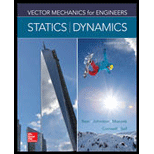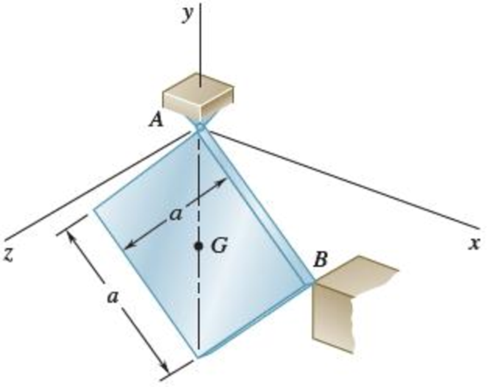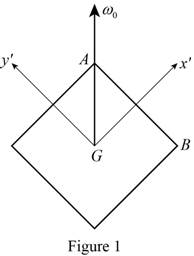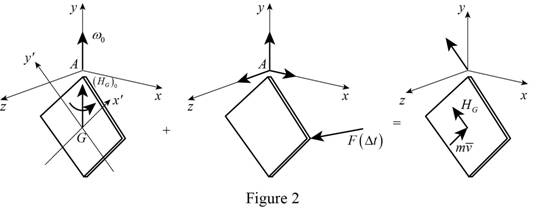
Concept explainers
Determine the impulse exerted on the plate of Prob. 18.31 during the impact by (a) the obstruction at B, (b) the support at A.
18.31 A square plate of side a and mass m supported by a ball-and-socket joint at A is rotating about the y axis with a constant angular velocity ω = ω0j when an obstruction is suddenly introduced at B in the xy plane. Assuming the impact at B to be perfectly plastic (e = 0), determine immediately after the impact (a) the angular velocity of the plate, (b) the velocity of its mass center G.

Fig. P18.31
(a)
The impulse exerted
Answer to Problem 18.32P
The impulse exerted
Explanation of Solution
Given information:
The mass of the square plate is m.
The side of a square plate is a.
The angular velocity
Assume the impact to be perfectly plastic that is
Calculation:
Show the diagram of the system as in Figure (1).

The length of the diagonal of a square is obtained by multiplying the side with
The expression for the angular velocity in the
Here,
The expression for the angular velocity in the
The unit vectors along the
The expression for the initial angular momentum about the mass center
Here,
The expression for the moment of inertia in the
Here, m is the mass and a is the side of the square plate.
Due to symmetry, moment of inertia in the
The expression for the angular momentum about
Substitute
Calculate the angular velocity at B
Here,
Substitute
The matrix multiplication for vector product is done.
The corner B does not rebound after impact. Therefore the velocity of B after impact in the
Calculate the angular velocity about the mass center
Here,
Substitute
Substitute 0 for
The matrix multiplication for vector product is done.
The expression for the angular momentum about A as follows:
Here,
Calculate the angular momentum about G using the formula:
Substitute 0 for
Substitute
The matrix multiplication is done for vector product.
The initial velocity of mass center (
Calculate the initial momentum about A using the relation:
Here,
Substitute
Show the forces acting on the plate as in Figure (2).

The expression for the moment about A as follows:
The matrix multiplication for vector product is done.
Substitute equation (6) and equation (7).
Equate
Equate
Equate
Substitute
Therefore, the impulse exerted
(b)
Find the impulse exerted
Answer to Problem 18.32P
The impulse exerted
Explanation of Solution
Given information:
The mass of the square plate is m.
The side of a square plate is a.
The angular velocity
Assume the impact to be perfectly plastic that is
Calculation:
Calculate the velocity along the x, y and z axes
Consider the Equation (3).
Substitute 0 for
Substitute
The expression for the linear momentum of the system as follows:
Substitute 0 for
Therefore, the impulse exerted
Want to see more full solutions like this?
Chapter 18 Solutions
Vector Mechanics for Engineers: Statics and Dynamics
- Disk A has a mass mA = 3.5 kg, a radius rA = 255 mm, and an initial angular velocity wOA = 300 rpm clockwise. Disk B has a mass mB = 1.8 kg, a radius rB = 150 mm, and is at rest when it comes into contact with disk A. Knowing that µk : 0.33 between the disks and neglecting rolling friction, determine the moment of reaction on the support at C, in N-m. = 00 B A C TA TBarrow_forwardA drum with a 500-mm radius is attached to a disk with a radius of 250 mm. The disk and drum have a combined mass of 5 kg and a combined radius of gyration of 350 mm. A 12 kg block D is suspended by a wire that is warped around the drum. Another force P 100 N is applied to the wire that is warped around the disk. If the system is released from rest, neglecting the effect of axle friction determine: * (a) the acceleration of the block and support reactions at C * (b) the velocity of the block and the distance travelled by the block after 5 second * (c) the revolution by the drum just after 5 second. S00 mm P+ 250 mm Aarrow_forwardA long ladder of length l, mass m, and centroidal mass moment of inertia I is placed against a house at an angle 0=0O. Knowing that the ladder is released from rest, determine the angular velocity of the ladder when 0=02. Assume the ladder can slide freely on the horizontal ground and on the vertical wall.arrow_forward
- The 30-kg turbine disk has a centroidal radius of gyration of 175 mm and is rotating clockwise at a constant rate of 60 rpm when a small blade of weight 0.5 N at point A becomes loose and is thrown off. Neglecting friction, determine the change in the angular velocity of the turbine disk after it has rotated through (a ) 90°, (b ) 270°.arrow_forwardA 1.6-kg tube AB can slide freely on rod DE which in turn can rotate freely in a horizontal plane. Initially the assembly is rotating with an angular velocity of magnitude w = 5 rad/s and the tube is held in position by a cord. The moment of inertia of the rod and bracket about the vertical axis of rotation is 0.30 kg.m2 and the centroidal moment of inertia of the tube about a vertical axis is 0.0025 kg.m2If the cord suddenly breaks, determine (a) the angular velocity of the assembly after the tube has moved to end E, (b) the energy lost during the plastic impact at E.arrow_forwardTwo uniform cylinders, each of mass m = 6 kg and radius r = 125 mm, are connected by a belt as shown. If the system is released from rest when t = 0, determine (a ) the velocity of the center of cylinder B at t=3s, ( b) the tension in the portion of belt connecting the two cylinders.arrow_forward
- A 240-lb block is suspended from an inextensible cable which is wrapped around a drum of 1.25-ft radius rigidly attached to a flywheel. The drum and flywheel have a combined centroidal moment of intertia of 10.5 lb-ft-s^2. At the instant shown, the velocity of the block is 6 ft/s directed downward. The bearing at A as a frictional moment of 60 lb-ft. What is the kinetic energy of the system after the block moved after 4ft? (in ft-lb)arrow_forward2) A slender uniform 30 kg bar is hinged off center and swings down on a vertical plane. In the configuration shown the angular speed of the bar is co = 2 rad /s. Knowing that the length of the bar is - 8m, the mass moment of inertia about the center of mass Gis la= me 12, and the distance between G and O equals 2m, determine the force at the smooth hinge O. 30arrow_forwardTwo uniform cylinders, each of weight W = 14 lb and radius r = 5 in., are connected by a belt as shown. If the system is released from rest, determine (a ) the velocity of the center of cylinder A after it has moved through 3 ft, (b) the tension in the portion of belt connecting the two cylinders.arrow_forward
- A large 3-lb sphere with a radius r = 3 in. is thrown into a light basket at the end of a thin, uniform rod weighing 2 lb and length L= 10 in. as shown. Immediately before the impact, the angular velocity of the rod is 3 rad/s counterclockwise and the velocity of the sphere is 2 ft/s down. Assume the sphere sticks in the basket. Determine after the impact (a) the angular velocity of the bar and sphere, (b) the components of the reactions at A.arrow_forwardProblem (4) An 8-kg gear with a radius of 80 mm has a centroidal radius of gyration of 50 mm. A 5-kg slender rod AB is attached to the center of the gear while the pin at B is free to slide along the vertical slot (negligible friction). When 0 = 60°, the system is released from rest. Determine S0 mm (a) the velocity of the center of the gear when 6 = 15° (b) the velocity of pin B when 0 = 15°. 320 imm BOarrow_forwardQ. A uniform hemisphere of mass m = 5 kg. and radius r = 0.5m. is released from rest on a horizontal surface in the position when OG is horizontal as shown in the figure below. The mass centre G of the hemisphere is at a distance (3/8)r from point O and its mass moment of inertia about O is I₁ = (2/5)mr². If the friction between the hemisphere and the horizontal surface is sufficient to prevent slipping, ( (3/8)r G (b) set up a global reference axes system of your choice, and draw the free body, kinematic and kinetic diagrams for the hemisphere showing all the forces and moments acting on it at the initiation of its motion, (c) write down the relevant kinetic and kinematic relationships with respect to the reference axes system, andarrow_forward
 Elements Of ElectromagneticsMechanical EngineeringISBN:9780190698614Author:Sadiku, Matthew N. O.Publisher:Oxford University Press
Elements Of ElectromagneticsMechanical EngineeringISBN:9780190698614Author:Sadiku, Matthew N. O.Publisher:Oxford University Press Mechanics of Materials (10th Edition)Mechanical EngineeringISBN:9780134319650Author:Russell C. HibbelerPublisher:PEARSON
Mechanics of Materials (10th Edition)Mechanical EngineeringISBN:9780134319650Author:Russell C. HibbelerPublisher:PEARSON Thermodynamics: An Engineering ApproachMechanical EngineeringISBN:9781259822674Author:Yunus A. Cengel Dr., Michael A. BolesPublisher:McGraw-Hill Education
Thermodynamics: An Engineering ApproachMechanical EngineeringISBN:9781259822674Author:Yunus A. Cengel Dr., Michael A. BolesPublisher:McGraw-Hill Education Control Systems EngineeringMechanical EngineeringISBN:9781118170519Author:Norman S. NisePublisher:WILEY
Control Systems EngineeringMechanical EngineeringISBN:9781118170519Author:Norman S. NisePublisher:WILEY Mechanics of Materials (MindTap Course List)Mechanical EngineeringISBN:9781337093347Author:Barry J. Goodno, James M. GerePublisher:Cengage Learning
Mechanics of Materials (MindTap Course List)Mechanical EngineeringISBN:9781337093347Author:Barry J. Goodno, James M. GerePublisher:Cengage Learning Engineering Mechanics: StaticsMechanical EngineeringISBN:9781118807330Author:James L. Meriam, L. G. Kraige, J. N. BoltonPublisher:WILEY
Engineering Mechanics: StaticsMechanical EngineeringISBN:9781118807330Author:James L. Meriam, L. G. Kraige, J. N. BoltonPublisher:WILEY





